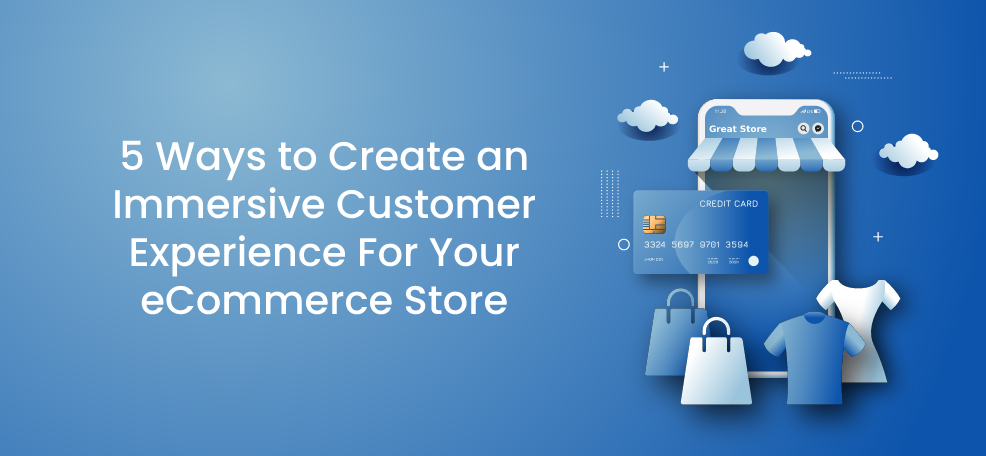Customer experience determines how eager customers are to make a purchase, return to your site, or recommend you to friends. Creating a quality experience is key to eCommerce success.
Research from PWC shows that 43% of customers are willing to pay more for a good customer experience. By making that experience immersive, you give customers even more incentive to spend.
And now, technology makes that even easier. With a host of tools and strategies at your disposal for engaging your customers, you can boost your sales, build loyalty, and scale in the competitive digital world.
Understand what an immersive customer experience is, and then use these five strategies for creating such an experience for your eCommerce store.
What is an Immersive Customer Experience?
Long before the COVID-19 pandemic, immersion in customer experience (CX) defined the landscape of digital marketing and sales. With so much content vying for an audience’s attention, immersion became necessary to get your message across.
Now, immersion is more important than ever. COVID shot eCommerce spending up to $861.12 billion across 2020, and where there’s more money, there’s more competition.
Across marketing, sales, and customer retention, you’ll need experiences that engage users on an emotional level. To achieve this, you must reach out across channels, use multimedia, and personalize content to your target audiences.
These tools define an immersive eCommerce experience. Through their application, you can create relevant, memorable, and satisfying content marketing and store experiences designed to boost your sales.
Fortunately, technology is here to help. From web hosting platforms to Virtual Reality (VR), you can build experiences that play on everything a customer wants from their eCommerce store.
But crafting these experiences effectively is where the challenge comes in. After all, using new tech and tools is rarely easy. And with stakes this high for engaging new customers and clients, you’ll need a careful, practiced approach.
How to Create an Immersive Experience
To craft an immersive CX for your eCommerce store, you need to consider how to effectively approach every level of the customer journey while adhering closely to your brand identity.
It takes preparation and know-how to create a truly immersive CX. Beginning with the ways you frame your content and ending with customer feedback, these strategies can help you immerse your customers in a high-quality, satisfying digital experience.
1. Define Your Values and Brand Identity
No matter what tech you use or what innovations you apply, the level of immersion your customers will feel will come down to how effectively you can coordinate your experience with what your brand is.
Apple is one company that understands this more than most others. For example, even the experience of opening an iPhone box is carefully coordinated to give the customer a sense of value and satisfaction.
The result is an experience they remember and one they associate intimately with the brand itself. Apple’s commitment to design and attention to detail down to the box their product comes in expresses Apple’s brand identity as one at the cutting-edge of design.
So when it comes to crafting your own eCommerce store experience, you want to consider similar values and what you want your brand to mean to your customers. These values are best set forward in a mission statement.
Put simply, a mission statement captures the passion behind a business venture. It indicates both the company’s goals and the reason for existence. For the Disney Corporation, for instance, this is to “entertain, inform, and inspire.”
By defining your values and your mission statement clearly, you can better plan immersive customer experiences that make sense with your brand. For example, building a VR platform for product selection can show that you’re dedicated to customization and technology.
Start with your values and passions and build your experiences from there. The result will be more authentic and therefore more impactful immersive customer experiences.
2. Map the Customer Journey
Once you define your values, it’s time to carefully map the customer journey to understand where immersive experiences are best applied.
The customer journey is key to success in an eCommerce platform. Understanding this helps you run a customer-driven business that values the importance of engagement and interaction while constantly delivering on customer needs.
The customer journey consists of four key parts. These are:
- Awareness
- Consideration
- Decision-making
- Evaluation
By exploring immersion at each one of these stages, you can help a customer remember their experience with you. This begins with helping them find you.
In advertising, your best approach is to leave customers with content they can remember. This could take the form of a powerful slogan, image, or video. Additionally, personalized messaging based on data-driven customer profiles will make this simpler.
Then, you can build immersion by playing into customer identity. What do your customers want? What do they need? What do they respond to and what do they not?
All these questions will help you build meaningful experiences from your eCommerce store. Defining customer needs with the help of data and narratives will let you apply solutions to your online shopping experience.
Map and evaluate the customer journey to determine where customer needs might not coordinate with what you have to offer. Then you can plan for immersion by making the experience as smooth as possible.
3. Personalize your Content Offerings
Almost nothing is as effective in creating immersion in a shopping experience as personalization. This means tailoring content offerings to each user individually, and the process is gaining popularity.
McKinsey data shows that 80% of customers not only want but expect personalization from retailers. They’re now used to experiences like those found on Amazon or Netflix, where the next new product or show is recommended to them based on their personal account data.
Amazon product recommendations are inspired by user shopping trends. Source: Amazon
As data collection and digital shopping experiences only improve over time, these expectations will only grow. For eCommerce companies, implementing personalization now is one of your best means for crafting immersive experiences tailored to every customer.
Here are just some of the ways that you can personalize your eCommerce store to improve your conversions:
- Offer complementary products or deals based on purchases.
- Target exploratory new customers with targeted offers.
- Greet signed-in customers with a welcome message.
- Adjust your content with geolocation targeting.
- Build pop-up content tailored to a user’s data.
While only a sampling of the ways you can build immersion through personalization, these strategies are all useful when it comes to improving experiences.
After all, virtually everyone on the internet dislikes pop-ups. However, they’ve been shown to produce conversion rates of up to 3.09%, according to Premio. Personalizing these ensure that they are effective rather than annoying.
Then, using customer data to give them exactly what they might want can never hurt. By using location, past purchase decisions, correlated data based on what other users purchased, and so much more, you can build an immersive digital store that feels like it’s engaging with you based on who you are as a person.
However, none of this would be possible without innovative new technology.
4. Use Technology to Innovate
Technology is key to a thriving eCommerce store. By exploring the technology and software solutions open to you and constantly pushing the envelope, you can continuously craft more immersive experiences. Typically, this revolves around data collection.
Big data makes the world go round. Estimates suggest that 1.145 trillion MB of data is collected on the web every day, a number that is continuously on the rise. In eCommerce, this information is used to improve products, services, and offerings to create more immersive CX.
But gathering this data can be difficult — not to mention analyzing it for actionable insights. Achieving these tasks effectively requires the help of technology.
Artificial intelligence and machine learning algorithms are key in this regard. These tools make it possible to synthesize compelling customer profiles based on individual data to provide personalization accordingly.
Meanwhile, immersive opportunities are expanding with the use of new techs like VR and AR. These are systems that allow an audience to step directly into a virtual marketplace, and their implications in digital commerce are compelling.
Furniture giant Ikea is one example of a company that has applied AR in its online shopping experience. Through its mobile app, users can see more or less exactly how a piece of furniture would fit in their home. You can’t get much more immersive than that.
By exploring technological innovations and constantly thinking outside the box, you too can create eCommerce experiences like this. Evaluate what customers’ challenges are when shopping online, and then ask yourself how technology might be used to solve these problems.
5. Continuously Gather Feedback
Gathering customer feedback is one of the most essential aspects of eCommerce. All of your efforts come down to how well you can assess CX satisfaction and needs.
Your approach to data collection, mapping the customer journey, personalizing content, and applying technology all hinge on your ability to assess how customers feel about their experience. You can’t build immersion based on guesswork alone.
Both before and after you launch your website, implementing a system of feedback gathering is one of the most important things you should do. This should be done in a way that doesn’t take users out of the experience but helps them reflect constructively on their shopping.
Ask users if they were satisfied with their eCommerce experience, giving them simple yes or no options. From there, you can offer customers the opportunity to expand if they wish and only if they wish.
Your ability to immerse your customers in their online shopping comes down to how well you can target and apply their feedback. From the beginning data collection stages to these simple methods of gauging customer satisfaction, feedback can always help you improve.
Maximizing Potential Through Immersion
Maximize your own potential by integrating these five methods for creating an immersive customer experience. From a clearly defined brand identity down to a system for gathering continuous customer feedback, the tools you need for greater immersion is at your disposal.
Take advantage of these tips and develop a customer experience your eCommerce shoppers will remember.









